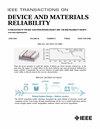Temperature Dependence of Single-Event Burnout Across Varying LET Levels
IF 2.3
3区 工程技术
Q2 ENGINEERING, ELECTRICAL & ELECTRONIC
IEEE Transactions on Device and Materials Reliability
Pub Date : 2025-06-09
DOI:10.1109/TDMR.2025.3578041
引用次数: 0
Abstract
This study investigates the influence of temperature on single-event burnout (SEB) in n-channel 115-V-rated vertical-diffused metal-oxide-semiconductor field-effect transistors (VDMOSFETs) subjected to irradiation by heavy ions of krypton and tantalum. The experiments spanned a temperature range from 25°C to 200°C, and it is indicated that a marked reduction in SEB sensitivity as the temperature increased. Our analysis methodically examines the interplay among the parasitic bipolar junction transistor (BJT) feedback mechanism, avalanche multiplication, charge collection, and SEB triggering processes. We propose a hypothesis that elevated temperatures decrease carrier mobility, reduce carrier lifetime, and diminish the impact ionization rate, which collectively leads to a reduction in charge collection and attenuates the lateral base current, thereby lowering SEB sensitivity. This hypothesis was substantiated through technology computer-aided design (TCAD) simulations. The findings reveal a consistent pattern in the temperature’s effect on SEB across all linear energy transfer (LET) levels examined, providing essential insights for the utilization of power VDMOS transistors in high-temperature, intense-radiation environments such as those encountered in space applications.不同LET水平的单事件燃尽的温度依赖性
本文研究了温度对氪和钽重离子辐照下n通道115 v额定垂直扩散金属氧化物半导体场效应晶体管(vdmosfet)单事件烧断(SEB)的影响。实验温度范围从25°C到200°C,结果表明,随着温度的升高,SEB的灵敏度显著降低。我们的分析系统地考察了寄生双极结晶体管(BJT)反馈机制、雪崩倍增、电荷收集和SEB触发过程之间的相互作用。我们提出了一个假设,升高的温度会降低载流子迁移率,降低载流子寿命,并降低冲击电离率,这些因素共同导致电荷收集减少和横向基极电流衰减,从而降低SEB灵敏度。通过计算机辅助设计(TCAD)模拟技术证实了这一假设。研究结果揭示了温度对所有线性能量传递(LET)水平的SEB影响的一致模式,为在高温、强辐射环境(如空间应用中遇到的环境)中使用功率VDMOS晶体管提供了重要的见解。
本文章由计算机程序翻译,如有差异,请以英文原文为准。
求助全文
约1分钟内获得全文
求助全文
来源期刊

IEEE Transactions on Device and Materials Reliability
工程技术-工程:电子与电气
CiteScore
4.80
自引率
5.00%
发文量
71
审稿时长
6-12 weeks
期刊介绍:
The scope of the publication includes, but is not limited to Reliability of: Devices, Materials, Processes, Interfaces, Integrated Microsystems (including MEMS & Sensors), Transistors, Technology (CMOS, BiCMOS, etc.), Integrated Circuits (IC, SSI, MSI, LSI, ULSI, ELSI, etc.), Thin Film Transistor Applications. The measurement and understanding of the reliability of such entities at each phase, from the concept stage through research and development and into manufacturing scale-up, provides the overall database on the reliability of the devices, materials, processes, package and other necessities for the successful introduction of a product to market. This reliability database is the foundation for a quality product, which meets customer expectation. A product so developed has high reliability. High quality will be achieved because product weaknesses will have been found (root cause analysis) and designed out of the final product. This process of ever increasing reliability and quality will result in a superior product. In the end, reliability and quality are not one thing; but in a sense everything, which can be or has to be done to guarantee that the product successfully performs in the field under customer conditions. Our goal is to capture these advances. An additional objective is to focus cross fertilized communication in the state of the art of reliability of electronic materials and devices and provide fundamental understanding of basic phenomena that affect reliability. In addition, the publication is a forum for interdisciplinary studies on reliability. An overall goal is to provide leading edge/state of the art information, which is critically relevant to the creation of reliable products.
 求助内容:
求助内容: 应助结果提醒方式:
应助结果提醒方式:


